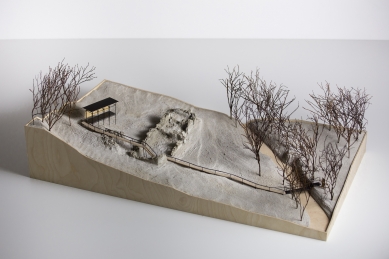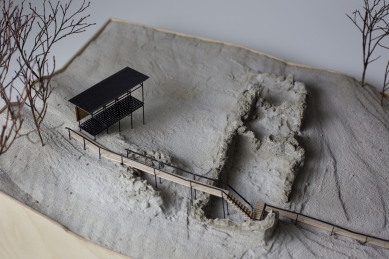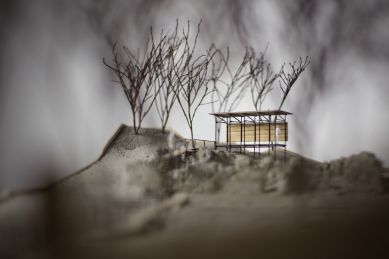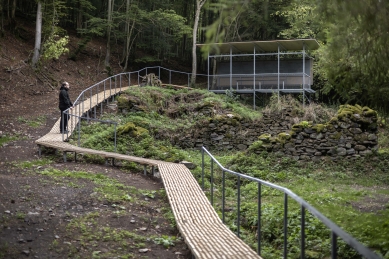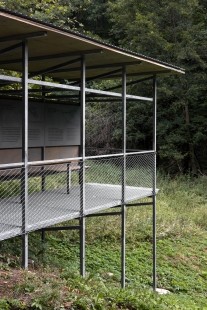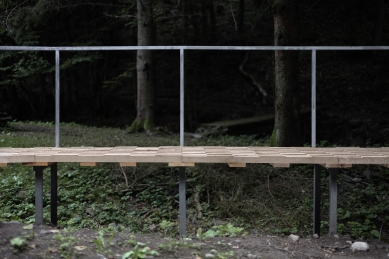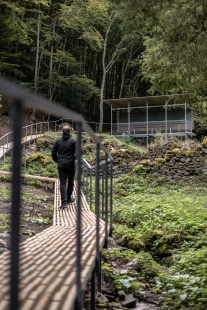
Revitalization of Počúvadlianske Mill

The revitalization of the Počúvadliansky Mill focuses on linking historical elements with a contemporary approach to presenting cultural heritage. The overall composition responds to the natural conditions of the site and leaves room for the conservation of the preserved parts of the building.
The Počúvadliansky Mill is located in the Štiavnické Hills, near the villages of Baďan and Počúvadlo. The site is significant for several reasons. Originally, there was a riverside water mill with an artificial water drive. A forest railway once led alongside the mill. The location is also a memorial site from World War II. It was a refuge for the partisan group Sitno. In 1944, the mill was attacked by the Edelweiss anti-partisan unit, which had numerical superiority. Some partisans fell in battle, others were captured, and the Germans subsequently burned the mill. This event is commemorated by a memorial for the fallen designed by the academic sculptor Vladimír Oravec.
A key point of the design is the presentation of the former mill drive, which is a characteristic element of the water mill. Symbolically, it is depicted as an ascending path that ends in a small observation point. Based on the recommendation of the Heritage Office, the route is altered in close proximity to the ruins, and the mill building is circled to prevent further degradation while leaving space for the conservation of the masonry. The viewpoint at the end of the path draws attention to the ruins of the mill, allowing visitors to sense the context of the mill and the original mill drive. It is a place designated for relaxation, seating, and at the same time educating visitors through information panels.
The revitalization of the Počúvadliansky Mill site is an important step for strengthening the local community and preserving heritage. GPS coordinates for those who wish to find it are 48.3571, 18.8556.
The Počúvadliansky Mill is located in the Štiavnické Hills, near the villages of Baďan and Počúvadlo. The site is significant for several reasons. Originally, there was a riverside water mill with an artificial water drive. A forest railway once led alongside the mill. The location is also a memorial site from World War II. It was a refuge for the partisan group Sitno. In 1944, the mill was attacked by the Edelweiss anti-partisan unit, which had numerical superiority. Some partisans fell in battle, others were captured, and the Germans subsequently burned the mill. This event is commemorated by a memorial for the fallen designed by the academic sculptor Vladimír Oravec.
A key point of the design is the presentation of the former mill drive, which is a characteristic element of the water mill. Symbolically, it is depicted as an ascending path that ends in a small observation point. Based on the recommendation of the Heritage Office, the route is altered in close proximity to the ruins, and the mill building is circled to prevent further degradation while leaving space for the conservation of the masonry. The viewpoint at the end of the path draws attention to the ruins of the mill, allowing visitors to sense the context of the mill and the original mill drive. It is a place designated for relaxation, seating, and at the same time educating visitors through information panels.
The revitalization of the Počúvadliansky Mill site is an important step for strengthening the local community and preserving heritage. GPS coordinates for those who wish to find it are 48.3571, 18.8556.
Atelier HAUS
The English translation is powered by AI tool. Switch to Czech to view the original text source.
0 comments
add comment


